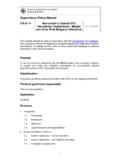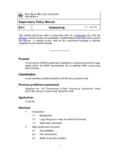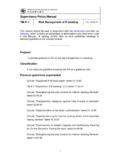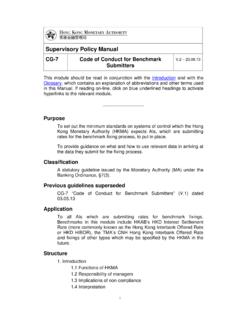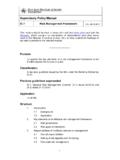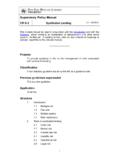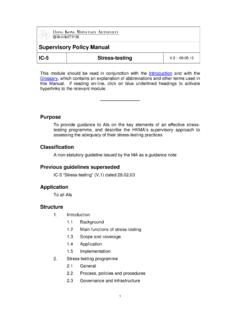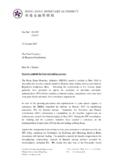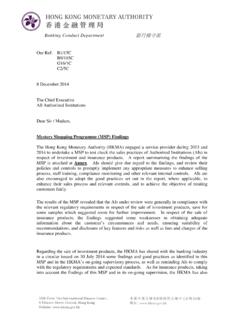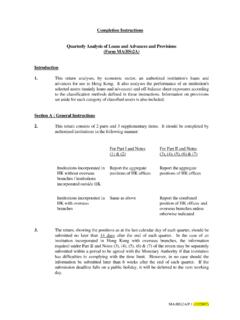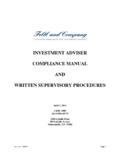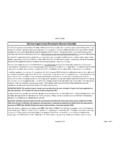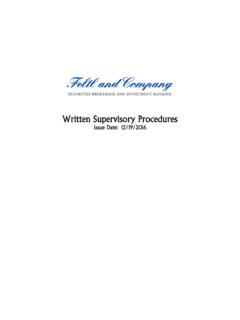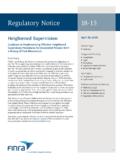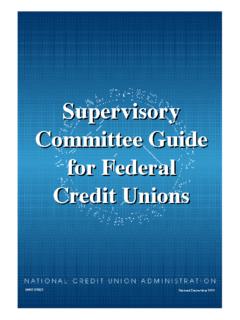Transcription of Supervisory Policy Manual - Hong Kong dollar
1 Supervisory Policy Manual IC-2 Internal Audit Function 1 This module should be read in conjunction with the Introduction and with the Gloss ary, which contains an explanation of abbreviations and other terms used in this Manual . If reading on line, click on blue underlined headings to activate hyperlinks to the relevant module. Purpose To set out the HKMA s expectations on the key role, responsibilities and qualities of an AI s internal audit function, and describe the approach that the HKMA will adopt in ass essing the eff ectiveness of the function. Classification A non-statutory guideline issued by the MA as a guidance note.
2 Previous guidelines superseded IC-2 Internal Audit Function ( ) dated Application To all AIs. Structure 1. Introduction Background Application 2. Hierarchy of responsibilities General Board of direc tors Senior management Internal audit function Audit Committee 3. Key qualities expected of internal audit function Supervisory Policy Manual IC-2 Internal Audit Function 2 Independence Authority and standing Objectivity and impartiality Resources and professional competence Continuity 4. W ork process of internal audit function General Audit plan Audit programme Audit procedures Audit reporting Follow-up procedures 5.
3 Relationship with risk management and compliance functions and external auditors Risk management and compliance functions External auditors 6. Outsourcing of internal audit function General Full or partial outsourcing Criteria for outsourcing Reporting arrangements 7. Supervisory assessment of internal audit function General Scope of assessment Means of assessment Supervisory actions Supervisory Policy Manual IC-2 Internal Audit Function 3 1. Introduction Background Paragraph 10 of the Seventh Schedule to the Banking Ordinance requires AIs to maintain, on and after authorization, adequate accounting systems and adequate systems of control.
4 It is therefore important for the board of direc tors ( Board ) and senior management of an AI to monitor and ass ess whether the AI s internal control systems are adequate, particularly in relation to ensuring effective governance and risk management, reliable and timely reporting of financial and management information, and compliance with relevant laws and regulations, Supervisory guidelines, market codes and standards, as well as internal policies and procedures. An internal audit function ( IAF ) is essential to the maintenance of adequate internal control systems in that it provides the Board and senior management of an AI with an independent, objective evaluation of the condition of the AI s systems and controls on an ongoing basis, and helps in improving their effectiveness by identifying weaknesses to be rectified and making recommendations for enhancement.
5 This independent evaluation proc ess is crucial to an AI s continuing development in the light of rapidly changing business environments that may bring about new risks and control challenges to the AI. An eff ective IAF als o f acilitates the supervis ory work of the HKMA by providing a valuable source of information that it may take into account for ass essing the quality of an AI s internal control systems. As noted in paragraph , the HKMA will have regular communication with an AI s internal auditors or other relevant persons to discuss issues of interest, including but not limited to the IAF s audit plan and its work and findings relating to the AI s internal control processes.
6 Application Every AI is expected to maintain an IAF that is appropriate for the size, nature, scope and complexity of its operations. W ith the increasing trend of AIs diversifying their activities into different products and Supervisory Policy Manual IC-2 Internal Audit Function 4 markets and the growing complexity of the business environments in which they operate, AIs should recognise the need to continuously upgrade their internal control systems, and to have an IAF that is equipped with the necessary expertise, resources and authority to safeguard the integrity of thes e s ystems.
7 Locally incorporated AIs should apply the standards set out in this module to their business activities on a group-wide basis. W here an AI has a significant branch or subsidiary abroad, the AI should consider establishing an internal audit office there to ensure the efficiency and continuity of the internal auditing work on those operations. Such overseas offices should be part of the AI s IAF and be able to comply with the standards in this module. The AI should also ensure that the IAF has unlimited access to the activities of all of its branches and subsidiaries, whether domestic or overseas, and that the IAF carries out on-site audits of those activities at sufficiently regular and timely intervals to ensure that internal control systems are functioning adequately and properly.
8 For AIs which are branches or subsidiaries of foreign banks (including subsidiaries of regulated financial holding companies), the HKMA will take into account the work of their group IAF on their local operations in assessing whether they satisfy the standards set out in this module. Where their local operations are sizeable in terms of the risks posed to the institutions themselves and the market as a whole, they are expected to have their own internal auditors in Hong Kong as part of their group IAF. Those with small operations in Hong Kong may, subject to the standards in this module, rely on their group IAF and/or competent external parties to whom internal audit activities have been outsourced (see section 6 for more details) to cover such operations.
9 AIs that do not conform fully with the standards set out in this module should satisfy the HKMA that alternative meas ures are in place which are equally robust in achieving the purposes of these standards. AIs are expected to refer periodically to the latest professional standards and best practices published from time to time by professional bodies such as the Institute Supervisory Policy Manual IC-2 Internal Audit Function 5 of Internal Auditors for further guidance on a more technical level. 2. Hierarchy of responsibilities General The effectiveness of an IAF depends to a large extent on the commitment of the Board and senior management of an AI to maintaining strong internal control systems that are responsive to the changing landscape of risks faced by the AI, as well as an adequately resourced and competent IAF to help ensure that this is the case.
10 Board of directors The Board has the ultimate responsibility for ensuring that eff ective internal control systems and processes are in place given the size, nature, scope and complexity of an AI s business activities. In this regard, the Board should, among other things have a broad understanding of the risks inherent in the AI s business activities (including those arising from any new developments, initiatives, products and operational changes), with a particular focus on those that may be material to the business and aff airs of the AI; ensure the competence of senior management in establishing, implementing and maintaining an adequate and effective system of internal controls.
